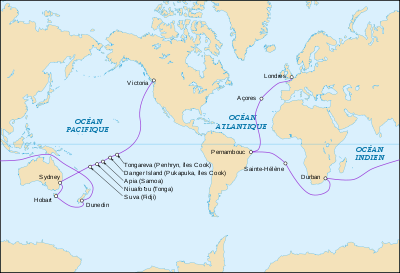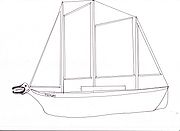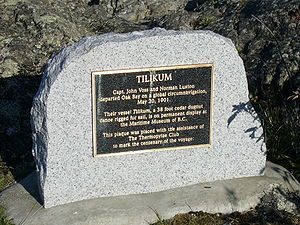
Tilikum (boat)
Encyclopedia



John Voss
John Claus Voss was a Canadian sailor best known for sailing around the world in a modified dug-out canoe he named Tilikum . He started in 1901 with his friend Norman Luxton and ending alone in 1904...
in April 1901. The boat was built in the early 19th century as a dugout canoe made from a large red cedar
Thuja plicata
Thuja plicata, commonly called Western or pacific red cedar, giant or western arborvitae, giant cedar, or shinglewood, is a species of Thuja, an evergreen coniferous tree in the cypress family Cupressaceae native to western North America...
log. The Tilikum was purchased for $80 in silver from a native woman (Voss describes her as a "siwash") in a transference ceremony allegedly sealed by a bottle of rye whiskey - the name Tilikum means "friend" in Chinook jargon
Chinook Jargon
Chinook Jargon originated as a pidgin trade language of the Pacific Northwest, and spread during the 19th century from the lower Columbia River, first to other areas in modern Oregon and Washington, then British Columbia and as far as Alaska, sometimes taking on characteristics of a creole language...
. Apparently, John Voss and his companion in this venture, Norman Luxton
Norman Luxton
Norman K. Luxton was a pioneer in the Canadian Rockies known as "Mr. Banff" . With John Voss, he attempted to sail around the world in a dug-out canoe...
, were inspired by the voyage of Joshua Slocum
Joshua Slocum
Joshua Slocum was the first man to sail single-handedly around the world. He was a Canadian born, naturalised American seaman and adventurer, and a noted writer. In 1900 he told the story of this in Sailing Alone Around the World...
, who sailed the 37 feet (11.3 m) sloop Spray
Spray (sailing vessel)
The S.V. Spray was a oyster sloop rebuilt by Joshua Slocum and used by him to sail single-handed around the world, the first voyage of its kind...
around the world a few years earlier and wrote a best selling book about his adventures.
The boat was refitted - reinforced, covered and rigged with sail, 230 square feet (21.4 m²) in total, and readied for her voyage. The Tilikum was sailed out of Oak Bay
Oak Bay, British Columbia
Oak Bay is a municipality located on the southern tip of Vancouver Island, in the Canadian Province of British Columbia, Canada. A member municipality of the Capital Regional District, it is a community east of and adjacent to the City of Victoria...
harbour on May 20, 1901, captained by Voss and mated by Luxton. The boat limped into harbour at Penrhyn Island
Penrhyn Island
Penrhyn is the most remote and largest atoll of the 15 Cook Islands in the south Pacific Ocean.-Geography:...
in the Cook Islands
Cook Islands
The Cook Islands is a self-governing parliamentary democracy in the South Pacific Ocean in free association with New Zealand...
on September 2, 1901. Luxton abandoned the effort after they reached Suva, Fiji on October 17, 1901. The Tilikum was mated by 10 more men between that time and when she finally pulled into harbour on the Thames in London, England in September, 1904.
On 25 October 1901, after leaving Suva, the mate, binnacle and compass were lost in 'large breaking seas'. Voss was now alone without a compass, 1200 miles (1,931.2 km) from Sydney. Tilikum is claimed to be the smallest deep-water ship to have ever entered Sydney Harbour until this time.
Tilikum arrived in Melbourne on 13 March 1902 and was exhibited in full rig in Collins Street. She was moved to another vantage point at the Exhibition Buildings, but during loading onto a 'wagon', the hook broke and she was damaged, with splits appearing in five different places. Voss repaired it himself using thin steel ribs.
She was then sailed on Lake Wendouree, Ballarat, and presented with a new set of sails by local yachtsmen, before travelling to Geelong to be returned to the sea.
Voss was elected a Fellow of the Royal Geographical Society
Royal Geographical Society
The Royal Geographical Society is a British learned society founded in 1830 for the advancement of geographical sciences...
in London after lecturing in Britain about the voyage.
Captain John Voss published his sailing memoir as The Venturesome Voyages of Captain Voss in 1913. The Tilikum was placed on display in London and changed hands a number of times, losing her bowsprint and masts over time. In 1929, the Furness Shipping Line returned Tillikum to Victoria, British Columbia
Victoria, British Columbia
Victoria is the capital city of British Columbia, Canada and is located on the southern tip of Vancouver Island off Canada's Pacific coast. The city has a population of about 78,000 within the metropolitan area of Greater Victoria, which has a population of 360,063, the 15th most populous Canadian...
. She underwent restoration beginning in 1936 by the Thermopylae Club before she was moved into the Maritime Museum
Maritime Museum of British Columbia
The Maritime Museum of BC reflects the Pacific maritime history and culture of Canada's west coast, with an exhibits and public program mandate for research, education, and partnership.-History:...
in 1965 and has remained on display there since.
Norman Luxton
Norman Luxton
Norman K. Luxton was a pioneer in the Canadian Rockies known as "Mr. Banff" . With John Voss, he attempted to sail around the world in a dug-out canoe...
kept notes of the voyage; his Tilikum Journal, edited by his daughter Eleanor was published in 1971.
Further reading
- The Age (Melbourne) 11, 14, 25 March 1902; 23 April 1902.

